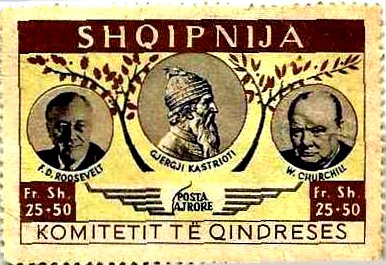 |
| 1941, Albania Govt in Exile FDR Churchill Imperfs,(F D Roosevelt, W Churchill, and Gjergj Kastrioti) |
Albania Govt in Exile FDR Churchill Imperfs,(F D Roosevelt, W Churchill, and Gjergj Kastrioti) 25 Fr 50 Sh, 1945 MN H
Text: Albania 25 Fr 50 Sh, SHQIPNIJA, KOMITETIT TE QINDRESES, F D Roosevelt, W Churchill, and Gjergj Kastrioti,
Condition: MN H
Title: Shqipnija
Face value: 25+50
Country/area: Albania
Icon-information
Year: 1941
Basic colour: Green,
Olive
Usage: Airmail
Type: Stamp
Theme: Celebrities
Person themes: Churchill, Winston (1874–1965), Roosevelt, Franklin
D. (1882-1945)
Gum: Gummed
Buy Now: Bid Now:
Albanian Subversion
The Albanian Subversion is one of the
earliest and most notable failures of the Western covert paramilitary
operations behind the Iron Curtain. Based on wrong assessments about Albania,
and thinking that the country was ready to shake off its Stalinist regime, the
British SIS and the American CIA launched a joint subversive operation, using
as agents Albanian expatriates. Other non communist Albanians and many
nationalists worked as agents for Greek, Italian and Yugoslav intelligence
services, some supported by the UK and U.S. secret services. A Soviet mole, and
later other spies tipped off the missions to Moscow, which in turn relayed the
information to Albania. Consequently, many of the agents were caught, put on a
show-trial, and either shot or condemned to long prison terms at hard labor.
The Albanian subversion cost the lives of
at least 300 men and for a long time was one of the most carefully concealed
secrets of the Cold War. In 2006, some 2,300 pages of documents laying out
major parts of the Albania Project under its two major cryptonyms, BGFIEND and
OBOPUS, were declassified by a U.S. Government inter agency working group
acting under the terms of the Nazi War Crimes Disclosure Act. Those documents
are available at the National Archives in College Park, MD, within Record Group
263. A significantly important user's guide is available to assist researchers
in locating the documents.
Background
The reason behind the operation in
Albania was a relatively simple one: it was separated from the Soviet Bloc by
Yugoslavia, which had split with Stalin's Soviet Union in June 1948. Albania
was also the poorest European nation, and was home to about one million people,
many still divided along semi-feudal lines. There were three major religious
groups and two distinct classes: those people who owned land and claimed feudal
privileges and those who did not. The landowners, only about 1% of the
population, held 95% of the cultivated land as well as the principal ruling
posts in the country's central and southern regions.
During World War II, the Albanian society
was split into several amorphous groups: nationalists, communists, royalists, and
traditionalists - the latter both tribal and feudal in nature. It was the
Communist National Liberation Front that emerged victorious, mainly due to the
ideological discipline instilled in their troops, but also because they were
the only force which had consistently fought the Italians and Germans. Many
nationalists and the royalists could not deny some collaboration with Italian
and/or German occupiers.
However, Albania was in an unenviable
position after World War II. Greece hungered for Albanian lands it claimed,
while Yugoslavia wanted Albania merged into a Balkan confederation. The Allies
recognized neither King Zog nor a republican government-in-exile, nor did they
ever raise the question of Albania or its borders at major wartime conferences.
No reliable statistics on Albania's wartime losses exist, but the United Nations
Relief and Rehabilitation Administration reported about 30,000 Albanian dead
from the war, 200 destroyed villages, 18,000 destroyed houses, and about
100,000 people made homeless. A number whose significance is further compounded
by the relatively small population of Albania: approximately 1,500,000 in
1938.[1] Albanian official statistics claim somewhat higher losses.
